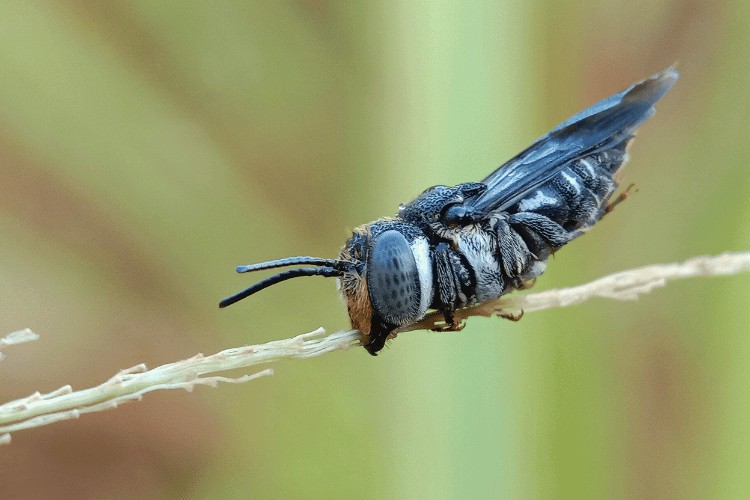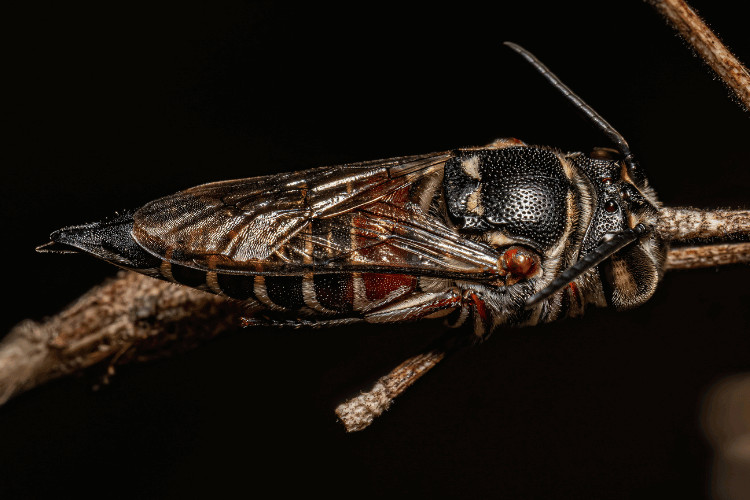Sharp-Tail Bees: An In-Depth Guide
If we ask you to imagine what a sharp-tail bee looks like, you’d probably imagine a bee with a knife-edge stinger, right?
What if we are to tell you that sharp-tail bees don’t have stingers at all? They can’t even sting you even if you want them to!
What’s with the name then? And what else is there to know? Let’s find out!
Description and Characteristics of Sharp-Tail Bees

Sharp-Tail Bees, scientifically known as Coelioxys acanthura, are a captivating species belonging to the Megachilidae family.
These remarkable insects are widely recognized for their unique features and intriguing behaviors. Found predominantly in North America, especially within the Nearctic subgenera, Sharp-Tail Bees are a common sight for casual observers who appreciate the wonders of nature.
Characteristics
- Distinctive Black Heads: One of the most noticeable features of Sharp-Tail Bees is their striking black heads, which contrast beautifully with their vibrant metallic-hued bodies.
- Abdominal Adaptations: The abdomen of Sharp-Tail Bees plays a crucial role in their nesting habits. Females possess a pointed abdomen, used for drilling into the nests of their host species, often Leafcutter Bees (Megachile), to lay eggs. That pointed abdomen is the reason they’re called sharp-tail bees.
- Nest Entrances: Sharp-Tail Bees have distinct nest entrances, which are characterized by circular holes leading to individual nests. These entrances are strategically crafted to minimize the chances of host species recognizing the impostor eggs.
- Mandibular Strength: With strong mandibles, these bees skillfully excavate and manipulate nesting sites, ensuring their young thrive in secure environments.
- Pollinator Role: Beyond their unique behaviors, Sharp-Tail Bees are essential pollinators, visiting a range of plants to collect nectar and inadvertently transferring pollen, aiding in plant reproduction.
- Abundant Hairs: Their bodies are covered in fine, abundant hairs that serve various purposes, including aiding in pollen collection and providing protection from environmental elements.
What Is the Purpose of Sharp-Tail Bees
Primarily, Sharp-tail bees play a significant role as pollinators, fostering the reproduction of a diverse range of plants through their foraging habits.
By collecting nectar from flowers and inadvertently transferring pollen, they contribute to the cycle of life for numerous plant species.
Sharp-Tail Bees Habitat and Foraging Preferences
Sharp-Tail Bees are versatile creatures that thrive across a spectrum of habitats in North America, particularly within the Nearctic subgenera. Woodlands, meadows, urban gardens, and even grasslands become their homes.
Their nesting habits in sandy or loamy soils emphasize their adaptability. These bees exhibit a preference for a variety of flowers (more on that soon), diligently collecting nectar while pollinating a diverse range of plants.
The black heads and metallic hues of their bodies make them easily recognizable as they flit from bloom to bloom.
This flexibility in habitat and foraging choices highlights their significance as contributors to the intricate web of pollination, ensuring the survival of various plant species.
Where Can You Find Sharp-Tail Bees
The specific habitat where you can find sharp-tailed bees will depend on the species of bee. For example, the shiny-vented sharp-tail bee (Coelioxys inermis) is found in dune systems and coastal areas. In contrast, the short-tailed sharp-tail bee (Coelioxys brevicauda) is found in forests.
Here are some tips for finding sharp-tailed bees:
- Look for them in sunny areas with flowering plants.
- Check bee hotels and other nesting sites.
- Look for them flying or resting on flowers.
- If you see a sharp-tailed bee, be sure to identify it carefully so that you can learn more about its life history.
Here are some of the flowers that sharp-tailed bees are attracted to:
- Bramble
- Thyme
- Bird’s-foot trefoil
- Viper’s-bugloss
- Mallows
- Knapweeds
- Sea holly
- Common fleabane
- White bryony
- Marjorams

Sharp-Tail Bees Life Cycle, Mating, and Nesting
The life cycle of sharp-tailed bees is similar to that of other solitary bees. The adult female bees emerge in the spring and summer and mate. The females then go on to search for nesting sites. Sharp-tailed bees are cleptoparasites, which means that they lay their eggs in the nests of other bees.
The female sharp-tailed bee will sneak into the open nest of a host bee, usually a leafcutter bee or a mason bee, and lay her egg on the food stores that the host bee has collected.
The sharp-tailed bee’s egg hatches quickly, and the larva then uses its large, curved, sharp jaws to kill the host bee’s offspring and consume the food stores intended for them.
The sharp-tailed bee larva then pupates and emerges as an adult bee the following spring. The lifespan of a sharp-tailed bee is typically about one year. However, some species can live for up to two years.
Here are some of the key stages in the life cycle of sharp-tailed bees:
- Egg: The female sharp-tailed bee lays her egg in the nest of a host bee.
- Larva: The larva hatches and feeds on the food stores that the host bee has collected.
- Pupa: The larva pupates and transforms into an adult bee.
- Adult: The adult bee emerges from the pupa and mates. The females then go on to search for nesting sites.
Importance of Sharp-Tail Bees in Ecosystems and Agriculture
Sharp-tailed bees are important pollinators in many ecosystems. They are attracted to a wide variety of flowers, and as they feed, they help to transfer pollen from flower to flower. This helps to ensure that plants are pollinated and that they can reproduce.
Sharp-tailed bees are particularly important for the pollination of wildflowers and native plants. They are also important for the pollination of some agricultural crops, such as blueberries, cranberries, and tomatoes.
Common Questions About Sharp-Tail Bees
What Do Sharp-Tail Bees Eat?
Sharp-Tail Bees, like many other bee species, have specific dietary preferences that are closely tied to their role as pollinators. These bees primarily feed on two main components: nectar and pollen.
However, sharp-tailed bees do not eat pollen or nectar directly. Instead, they indirectly consume these food sources by stealing them from other bees.
Are Sharp-Tail Bees Dangerous?
Sharp-tailed bees are not considered to be dangerous to humans. They do not have stingers, and they are not aggressive. However, they can be a nuisance if they are nesting in an area where people are frequently present.
If you find a sharp-tailed bee nest, it is best to leave it alone. The bees will not harm you unless they feel threatened. However, if you are concerned about the bees, you can contact a local beekeeper or pest control company for assistance.
Here are some tips for avoiding interactions with sharp-tailed bees:
- Do not disturb their nests.
- Avoid wearing bright colors or floral patterns, which can attract bees.
- If you are allergic to bees, take precautions to avoid skin contact, such as wearing long sleeves and pants and using insect repellent.
What Size Are Sharp-Tail Bees?
Sharp-tailed bees are medium-sized bees, typically ranging in length from 7 to 15 millimeters (0.28 to 0.59 inches).
The size of a sharp-tailed bee can vary depending on the species. For example, the shiny-vented sharp-tail bee (Coelioxys inermis) is slightly larger than the short-tailed sharp-tail bee (Coelioxys brevicauda).

How to Identify Sharp-Tail Bees?
Sharp-tailed bees are found in a variety of habitats around the world, but they are most common in open, sunny areas with flowering plants.
The best way to identify a sharp-tailed bee is to look for the following features:
- A pointed abdomen, which is longer in the females than in the males.
- Hairy eyes.
- A black or dark brown body, with some species having yellow or orange markings.
If you are unsure whether a bee is a sharp-tailed bee, you can take a picture of it and show it to an expert, such as a beekeeper or entomologist.
How to Attract Sharp-Tail Bees?
Here are some tips on how to attract sharp-tailed bees to your garden:
- Plant a variety of flowering plants that bloom throughout the spring and summer. Sharp-tailed bees are attracted to a variety of flowers, including bramble, thyme, bird’s-foot trefoil, and viper’s-bugloss.
- Provide nesting sites for sharp-tailed bees. Since they’re cleptoparasites, having ready-made nests for them can increase your chances of attracting them to your garden. You can provide nesting sites by building bee hotels or by leaving some dead wood in your garden.
- Avoid using pesticides. Pesticides can kill sharp-tailed bees and various other pollinators as well.
The Verdict
Sharp-tail bees are quickly distinguishable from other bees using two primary features; their black heads, and the absence of stingers.
Also, like most other solitary bees, sharp-tail bees don’t produce honey, so you can’t keep them in your garden in hopes of collecting honey from them. They do, however, act as pollinators that help crops and various flowers to reproduce, allowing the ecosystem to thrive.
You can attract them to your garden by planting the flowers they like to land on, and by creating nests that they can lay their eggs in.
You should also avoid getting too close and refrain from using pesticides to not scare the bees.
